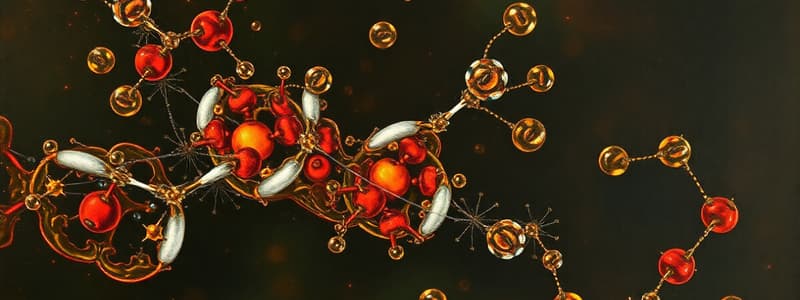Podcast
Questions and Answers
What is an apoenzyme?
What is an apoenzyme?
- An enzyme without its cofactor (correct)
- An enzyme that catalyzes reactions at high pH only
- An enzyme that has undergone a structural change
- An enzyme in its active form with a cofactor
How do enzyme cofactors affect enzymatic activity?
How do enzyme cofactors affect enzymatic activity?
- They increase the pH of the reaction environment
- They convert the enzyme into a different protein type
- They decrease the activation energy of the reaction (correct)
- They act as substrates in the reaction
What is the primary characteristic of the active site of an enzyme?
What is the primary characteristic of the active site of an enzyme?
- It is complementary in shape to the substrate upon binding (correct)
- It is where the substrate and product are released
- It has a fixed shape that does not change during enzyme function
- It prevents enzyme-substrate complexes from forming
Which of the following statements about proteolytic enzymes is correct?
Which of the following statements about proteolytic enzymes is correct?
What is a characteristic feature of the induced-fit model of enzyme function?
What is a characteristic feature of the induced-fit model of enzyme function?
What does a negative Gibbs Free Energy change (ΔG < 0) indicate about a reaction?
What does a negative Gibbs Free Energy change (ΔG < 0) indicate about a reaction?
How does the presence of an enzyme affect a chemical reaction?
How does the presence of an enzyme affect a chemical reaction?
In Michaelis-Menten kinetics, what does Km represent?
In Michaelis-Menten kinetics, what does Km represent?
Which statement correctly describes the relationship between reaction rate and reactant concentration in first-order reactions?
Which statement correctly describes the relationship between reaction rate and reactant concentration in first-order reactions?
What does kcat represent in enzyme kinetics?
What does kcat represent in enzyme kinetics?
What is the main purpose of the Lineweaver-Burk plot?
What is the main purpose of the Lineweaver-Burk plot?
In a Lineweaver-Burk plot, how is $K_M$ determined?
In a Lineweaver-Burk plot, how is $K_M$ determined?
What type of plot is created by plotting $V$ against $V/[S]$?
What type of plot is created by plotting $V$ against $V/[S]$?
What characteristic is common to allosteric enzymes?
What characteristic is common to allosteric enzymes?
What happens when an allosteric inhibitor binds to an enzyme?
What happens when an allosteric inhibitor binds to an enzyme?
What type of regulation involves a regulator molecule binding to an enzyme at a site other than the active site?
What type of regulation involves a regulator molecule binding to an enzyme at a site other than the active site?
In cooperativity, how does a substrate affect other active sites on an allosteric enzyme?
In cooperativity, how does a substrate affect other active sites on an allosteric enzyme?
The slope of an Eadie-Hofstee plot represents what kinetic parameter?
The slope of an Eadie-Hofstee plot represents what kinetic parameter?
Which of the following statements about competitive and noncompetitive inhibition is correct?
Which of the following statements about competitive and noncompetitive inhibition is correct?
Chymotrypsin is an example of which type of enzymatic behavior?
Chymotrypsin is an example of which type of enzymatic behavior?
Flashcards
Enzyme
Enzyme
A biological catalyst that speeds up biochemical reactions.
Substrate
Substrate
The reactant in an enzyme-catalyzed reaction.
Enzyme Specificity
Enzyme Specificity
Enzymes are typically highly specific, reacting only with their particular substrate.
Cofactor
Cofactor
Signup and view all the flashcards
Coenzyme
Coenzyme
Signup and view all the flashcards
Holoenzyme
Holoenzyme
Signup and view all the flashcards
Apoenzyme
Apoenzyme
Signup and view all the flashcards
Catalytic Site
Catalytic Site
Signup and view all the flashcards
Binding Site/Active Site
Binding Site/Active Site
Signup and view all the flashcards
Transition State
Transition State
Signup and view all the flashcards
Gibbs Free Energy (ΔG)
Gibbs Free Energy (ΔG)
Signup and view all the flashcards
ΔG < 0
ΔG < 0
Signup and view all the flashcards
ΔG > 0
ΔG > 0
Signup and view all the flashcards
First-order reaction
First-order reaction
Signup and view all the flashcards
Michaelis-Menten constant (Km)
Michaelis-Menten constant (Km)
Signup and view all the flashcards
Vmax
Vmax
Signup and view all the flashcards
kcat
kcat
Signup and view all the flashcards
Enzyme
Enzyme
Signup and view all the flashcards
Activation Energy
Activation Energy
Signup and view all the flashcards
Equilibrium
Equilibrium
Signup and view all the flashcards
Michaelis-Menten Kinetics
Michaelis-Menten Kinetics
Signup and view all the flashcards
Lineweaver-Burk plot
Lineweaver-Burk plot
Signup and view all the flashcards
Km
Km
Signup and view all the flashcards
Vmax
Vmax
Signup and view all the flashcards
Allosteric regulation
Allosteric regulation
Signup and view all the flashcards
Allosteric site
Allosteric site
Signup and view all the flashcards
Allosteric enzyme
Allosteric enzyme
Signup and view all the flashcards
Competitive inhibition
Competitive inhibition
Signup and view all the flashcards
Noncompetitive inhibition
Noncompetitive inhibition
Signup and view all the flashcards
Cooperativity
Cooperativity
Signup and view all the flashcards
Eadie-Hofstee diagram
Eadie-Hofstee diagram
Signup and view all the flashcards
Study Notes
Enzymes: Remarkable Catalysts
- Enzymes speed up biochemical reactions.
- Most enzymes are proteins, some are RNA.
- Enzymes stabilize the transition state, the high-energy point in a reaction.
- Enzymes function optimally at specific temperatures and pH levels.
Enzymes Catalyze Highly Specific Reactions
- Reactants in enzyme-catalyzed reactions are called substrates.
- Enzymes are highly specific, like proteolytic enzymes that hydrolyze peptide bonds between amino acids.
Proteases Readily Break Peptide Bonds
- Proteases are enzymes that catalyze the breaking of peptide bonds.
Many Enzymes Require Cofactors for Activity
- Enzyme cofactors are non-protein molecules or ions that assist enzymes.
Active Sites of Enzymes
- Enzymes have catalytic and binding sites.
- The catalytic site facilitates the conversion of substrates to products.
- The binding site, or active site, is highly specific allowing enzymes to interact selectively with substrates.
- The lock-and-key model suggests a rigid active site that is complementary to the substrate.
- The induced-fit model proposes a flexible active site that changes shape to fit the substrate.
Thermodynamics and Enzymes
- Gibbs Free Energy (G) is a useful thermodynamic function for understanding enzymes.
- The change in Gibbs free energy (ΔG) determines the direction of a reaction (ΔG < 0, proceeds to the right; ΔG > 0, proceeds to the left).
- Enzymes do not change the equilibrium of a reaction, but they accelerate the rate of reaction.
- Reactions with a negative ΔG will release energy.
Michaelis-Menten Kinetics
- Km is the Michaelis-Menten constant, a measure of the enzyme's affinity for the substrate.
- Vmax is the maximal reaction rate.
- kcat is the turnover number, a measure of the enzyme's catalytic efficiency.
- Enzyme kinetics are typically mathematical.
Allosteric Regulation
- Allosteric regulation involves a regulatory molecule binding to the enzyme at a site other than the active site.
- This alters the enzyme's activity.
- Competitive inhibition occurs when a molecule similar to the substrate competes for the active site.
- Noncompetitive inhibition occurs when the inhibitor binds to a separate site, reducing enzyme function.
Examples of Enzymes that do not obey Michaelis-Menten Kinetics
- Some enzymes, like allosteric enzymes, do not follow Michaelis-Menten kinetics because of their cooperative substrate binding.
Proteases
- Proteases use a catalytic triad to break peptide bonds.
- Proteases show intricate mechanisms.
Studying That Suits You
Use AI to generate personalized quizzes and flashcards to suit your learning preferences.




